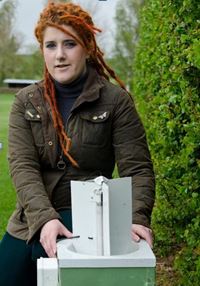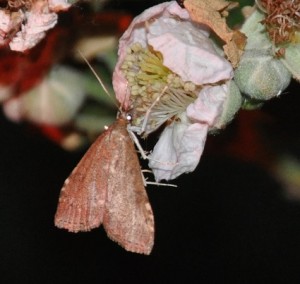A ‘Mother Lode’ of British Wildlife! Northampton PhD candidate shares moth research
Date 16.11.2015

PhD candidate Emma Coulthard has been working at Moulton College as an associate lecture where she lectured in conservation and wildlife management, while undertaking research part time – with her most recent research investigating the diversity and abundance of Britain’s moths. Emma’s research has found that land use, landscape architecture and metrics affect moth abundance, with woodland cover being very important.
Part of the University of Northampton’s Landscape and Biodiversity Research Group, Emma has been working under the guidance of the University’s Dr Duncan McCollin and Dr James Littlemore of Moulton College. Here, Dr James Littlemore explains more about Emma’s fascinating work…
“When you think of iconic and charismatic wildlife species inhabiting the patchwork landscape of Britain’s countyside, what do you think of? Perhaps boisterous badgers bustling along hedgerows? Maybe majestic red kites drifting through the Northamptonshire skies in the search for carrion? Even beautiful butterflies doggedly fluttering amongst flower rich meadows? Yet what about the silent and largely forgotten groups of animals you may never see – are they no less important?
One such group are moths – with a staggering 2,500 species resident in Britain, they remain a fascinating and diverse group of insects that are largely nocturnal in habit. They perform a valuable ecosystem service in farmland habitats, both as pollinators and as part of the wider food web. Yet sadly the Butterfly Conservation Trust recently reported that larger moth species have declined by almost a third during the 40-year period from 1968 to 2007. Changing farming practices, agricultural intensification, a lack of sympathetic habitat management, climate change and light pollution seem to be cumulatively driving this process, particularly in the south of England.
So what can we do about fighting this decline? Well to better inform conservation decision making for this insect group, last week PhD candidate Emma Coulthard shared her innovative thesis which examined habitat and landscape-scale effects on the abundance and diversity of macro-moths (Lepidoptera) in intensive farmland. Emma explained: “I have had many sleepless nights studying this amazing group of animals, but it has all been worth it! My research has showed that land use and the landscape architecture and metrics were affecting moth abundance, with woodland cover being very important.”
Emma continued: “I trapped moths at night using light ‘traps’ – and no moths were harmed, so don’t worry! I found 139 different species inhabiting farmed landscapes locally, and that the moths were using the networks of hedges to disperse along. Moths may even be acting as pollinators for one of the wild foragers’ favourite plant species – the bramble.
“I have been able to travel all over the world to communicate my findings and am very grateful to the Thomas Harrison Trust at the College for funding my research and expanding what we know about this very elusive group of insects.” Since leaving Moulton and the University of Northampton, Emma has been working as an ecological consultant.
Pictures: Top: Emma Coulthard. Below: Olive Pearl Moth.
